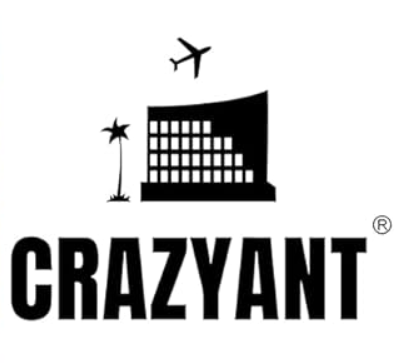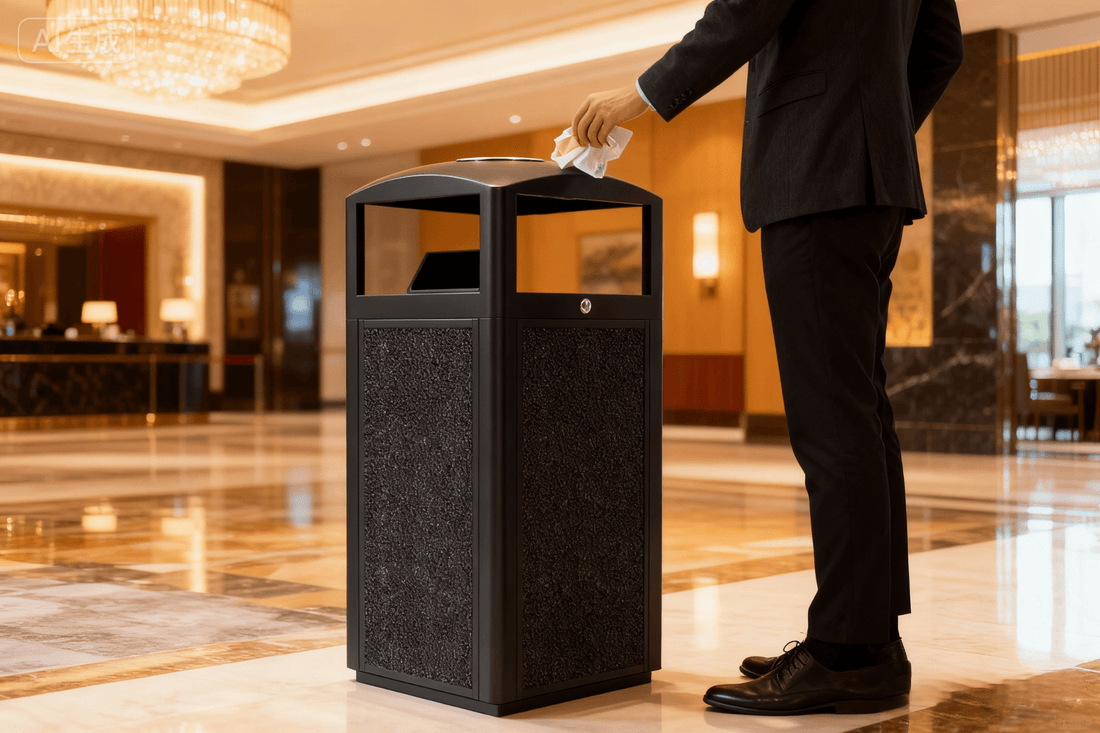Every hotel manager knows waste management is an operational expense. But few realize they're hemorrhaging thousands annually through something as basic as trash can sizing.
The difference isn't about buying premium bins. It's about strategic capacity planning that most properties overlook entirely.
When your housekeeping team makes unnecessary collection rounds or guests photograph overflowing receptacles for Google reviews, those aren't isolated incidents. They're symptoms draining your budget month after month.
The Real Cost of Overflowing Trash Cans in Hotel Lobbies
Your front desk staff won't tell you, but they notice every time the lobby trash can overflows before the scheduled pickup.
So do your guests.
Undersized waste receptacles in high-traffic areas create a domino effect. Housekeeping gets pulled from planned tasks to handle emergency collections. Staff morale drops when they're constantly firefighting instead of following efficient routines.
- 15-20 unplanned labor hours weekly (30% of collections responding to overflow)
- $280-360 weekly in reactive labor costs
- $14,560-18,720 annually in overflow-driven collections alone
Guest perception carries hidden costs too. According to hospitality reputation research, cleanliness issues in public spaces appear in 23% of negative hotel reviews. Overflowing bins signal poor maintenance standards—directly impacting booking conversion rates.
The root cause? Most hotels select capacity based on what "looks right" rather than actual waste generation data.
A hotel lobby serving 40 guests per hour generates approximately 12-16 pounds of waste every 4 hours. A 13-gallon bin reaches capacity in roughly 3 hours. If your pickup schedule assumes 6-hour intervals, you're engineering overflow into operations.

Half-Empty Bins, Full Labor Costs: The Oversizing Trap

The opposite problem costs just as much, but it's invisible on your daily checklist.
Walk through your property during collection rounds. How many bins are less than half full when serviced? If the answer is "most of them," you're paying for unnecessary labor.
The Oversizing Cost Breakdown
| Scenario | Current State (Oversized) | Optimized State | Annual Savings |
|---|---|---|---|
| Bin Configuration | 20 bins, serviced 2x daily | 20 bins, right-sized capacity | - |
| Bins Below 50% at Collection | 12 bins (60%) | 3 bins (15%) | - |
| Unnecessary Collections | 12 bins × 2 services = 24/day | 3 bins × 2 services = 6/day | 18 fewer/day |
| Daily Labor Wasted | 1.5 hours ($27/day) | 0.3 hours ($5.40/day) | $21.60/day |
| Monthly Cost | $810 | $162 | $648 |
| Annual Cost | $9,720 | $1,944 | $7,776 |
Based on $18/hour housekeeping rate and 3 minutes per collection stop
Why This Happens:
- A housekeeper spends the same 2-3 minutes servicing a 40% full bin as an 85% full one
- Liner costs remain identical regardless of fill level
- Trip time down the hallway stays the same
The EPA's waste reduction studies demonstrate that proper container sizing can reduce collection frequency by 18-30% without any change in waste generation.
For property managers looking to calculate exact cost savings based on their current setup, our detailed analysis breaks down which commercial bin size cuts costs by 40% across different hotel zones and traffic patterns.
The Hidden Impact: When cleaning staff service half-empty bins repeatedly, morale suffers. Workers recognize their routes include unnecessary stops, internalizing the inefficiency.
How to Calculate the Right Trash Can Size for Each Hotel Zone
Guesswork has no place in capacity planning. The right bin size emerges from observation, not catalog browsing.
The Calculation Framework
Required Capacity = (Waste Per Hour × Hours Between Services) × 1.2
The 1.2 multiplier provides a 20% buffer, keeping bins in the optimal 75-85% range.
Example: Your main entrance generates 2 gallons/hour. With 6-hour service intervals:
- (2 × 6) × 1.2 = 14.4 gallons needed
- A 16-gallon receptacle matches this perfectly
Recommended Capacity by Zone
| Hotel Zone | Capacity Range | Service Frequency | Notes |
|---|---|---|---|
| High-Traffic (Lobby, Main Entrance) | 16-23 gallons | 3-4× daily | Coffee service increases volume |
| Moderate Traffic (Elevator Lobbies, Corridors) | 13-16 gallons | 2× daily | Consistent generation rates |
| Seasonal Areas (Pool Deck, Outdoor Dining) | 20-32 gallons | Varies by season | Adjust capacity seasonally |
| Event Spaces (Meeting Rooms) | 13-20 gallons | Based on bookings | Use flexible/temporary bins |

Monitoring Process (One Week Required)
- Record fill percentage at each scheduled service time
- Note hours elapsed since last collection
- Track variations between weekday/weekend patterns
- Document any overflow incidents
Research on commercial waste container optimization shows properties using data-driven sizing reduce waste management labor by 25-35% compared to standardized approaches.
Critical Insight: Collection frequency and capacity work together. A 13-gallon bin serviced every 4 hours handles identical volume to a 20-gallon bin serviced every 6 hours.
Strategic Bin Placement: Reducing Cleaning Routes by 30%
Where you put trash cans matters as much as what size they are.
Most hotels place receptacles based on aesthetics or "coverage." That approach ignores the labor cost of servicing scattered collection points.
Time Per Collection Stop
- Walk to bin location: 15-30 seconds
- Remove and tie liner: 20-30 seconds
- Insert new liner: 15-20 seconds
- Walk to next location: Variable
Total: 60-90 seconds per bin + transition time
The Route Efficiency Math
Scenario: Reduce collection points from 25 to 18 bins
- Time saved per round: 10-15 minutes
- Daily savings (3 rounds): 30-45 minutes
- Annual hours recovered: 180-270 hours
- Annual savings at $18/hour: $3,240-4,860
Strategic Placement Principles
Consolidate along housekeeping routes - Instead of 8 bins distributed evenly across a floor, use 6 larger-capacity receptacles at route intersections.
Centralize in open areas - A lobby with two 23-gallon bins strategically positioned outperforms four 13-gallon bins scattered around the perimeter.
Follow natural traffic flows - Bins along main pathways get used more effectively than those in corners, reducing secondary cleanup.
According to IFMA's facility management best practices, properties that map collection routes before finalizing bin placement reduce waste management labor by 28-35%.
Testing Approach: Use temporary markers to simulate bin locations for two weeks. Monitor staff efficiency and guest adaptation before permanent installation.
Seasonal Adjustments: When Your Trash Bins Need to Flex
Your hotel's waste generation fluctuates. Your bin capacity should too.
Permanent vs. Flexible Capacity
| Approach | Pool Deck Example | Annual Cost Impact |
|---|---|---|
| Permanent Oversizing | Use 32-gallon bins year-round | Servicing half-empty bins 8-10 months |
| Flexible Capacity | 20-gallon baseline + temporary 13-gallon units in summer | Capital deployed only when needed |
Cost Comparison:
- Permanent 32-gallon bin: $200-280 each
- Five temporary 13-gallon units: $600-750 total (serve multiple locations)
When to Add Temporary Capacity
- Summer pool season (July-August)
- Holiday events and conferences
- Wedding season bookings
- Convention periods
Event Space Strategy: Maintain baseline capacity for typical operations. Deploy modular 13-16 gallon units during booked events. Store compactly when not needed.
According to hospitality operational research, hotels implementing seasonal capacity adjustment reduce annual waste management costs by 15-22%.
Studies from the Hotel Association of Canada show that flexible waste management systems improve both cost efficiency and environmental sustainability ratings.
Action Step: Track waste volumes monthly for one full year. Identify periods where temporary additions make sense and budget for modular bins accordingly.
The 75-85% Rule: Your Trash Can Capacity Sweet Spot
Every collection round should find bins in the 75-85% full range.
Why This Range?
- Below 60%: Oversizing or over-servicing (wasted labor)
- 75-85%: Optimal efficiency (bins ready for service without overflow risk)
- Above 90%: Overflow risk and guest complaints
Audit Your Property
During normal collection rounds, record fill percentages for every public area bin.
Success Metric: 70%+ of bins should hit the 75-85% target at service time.
Three-Category Correction Process
1. Chronic Overflow Locations (Consistently >90%)
- Immediate capacity increase or frequency adjustment needed
- Highest-cost problems (guest complaints + unscheduled labor)
2. Consistently Under-Filled (<50% at service)
- Downsize bins or extend service intervals
- A bin reaching 75% in 8 hours vs. 6 hours eliminates one daily collection
3. Borderline Cases (60-75% range)
- Test extended intervals
- If 70% after 6 hours becomes 85% after 8 hours, cut daily collections without overflow risk
Waste management industry data shows facilities using fill-percentage targeting reduce total collection trips by 25-35% annually.
Implementation Timeline: Track adjustments over 30 days. Properties achieving 75-85% across 80%+ of collection points consistently report 30-40% reductions in waste management labor costs.
The National Waste & Recycling Association provides additional benchmarking data showing that optimized fill-rate targeting delivers measurable ROI within the first quarter of implementation.
Start Today: Equip supervisors with simple checklists to record fill levels during existing rounds. Within two weeks, you'll have data to eliminate thousands in annual waste.
Making the Change
The path to 30-40% cost reduction doesn't require revolutionary changes. It requires measurement, adjustment, and consistency.
Priority Order:
- Fix chronic overflow problems (damage guest experience + drain resources)
- Address over-serviced bins (wasted labor on half-empty collections)
- Optimize placement along efficient routes
- Implement seasonal flexibility
Every properly-sized bin, every optimized route, every collection that happens when genuinely needed—these incremental improvements compound into substantial annual savings.
The path to reducing waste management costs by 30-40% is clearer than most property managers realize: measure current fill rates, calculate optimal capacity by zone, and adjust both bin sizing and collection frequency accordingly. These fundamentals eliminate the costly cycle of overflow emergencies and wasted collection trips.
If your property is ready to upgrade to commercial-grade bins designed for long-term hospitality use, explore our collection of steel receptacles built to last.
Questions about your specific setup? We're available at info@crazyant-hotel.com.

